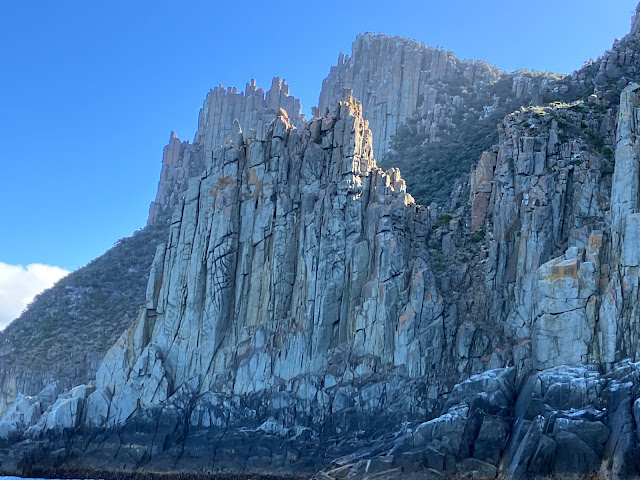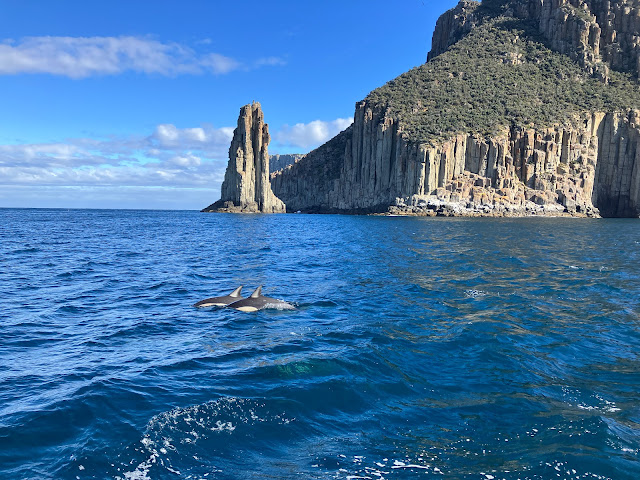For our last day in Tasmania, we decided to explore a couple of things on the Tasman Peninsula. One of the definite must-see activities in all of Tasmania is to visit the Port Arthur Historic site, one of the most significant of the 11 World Heritage Convict Sites in Australia.
When Tasmania was known as Van Diemen's Land, it had a notorious reputation as a brutal penal colony. While criminals of all stripes were sentenced to "transportation" to Australia in various other locations, Port Arthur was where criminals were sent if they committed a second offense after arriving in Australia or if they were considered particularly unrepentant and rebellious. It was intended to be an inescapable location for the worst of the worst, kind of like Alcatraz in California. However, there were also some very young criminals detained here -- records show there was a prisoner here aged 9. At that time, anyone over the age of seven was considered old enough to be punished in the criminal system for actions as minor as petty theft or pickpocketing. Here at Port Arthur, boys under 17 were kept in their own prison facility nearby so that they didn't mix with the hardened criminals in the adult penitentiary. For the men and boys here, transportation basically amounted to forced migration and forced labor, and life here in the convict cells was very hard. In the main penitentiary, prisoners were separated by floor: the top floor held 348 men in a big bunk-style dormitory, the lower floors held men in individual cells, sometimes in light irons, and the ground floor had the cells for the most dangerous offenders -- small, dark rooms where they were kept shackled in heavy irons. The photo shows just how small those ground floor cells were -- barely enough room to lie down, each cell separated by a thick impenetrable wall.
At the visitor center, we were invited to pick from a deck of cards. The card you chose gave you the name of an actual person who lived here at Port Arthur, either as a prisoner or a military officer. In the visitor center, you could look up a few historical facts about your person, and then as you explore the sprawling grounds you look for a marker that indicates that you are in the area where your person lived or worked. I drew a convict named Sarah Evans, a laundress from Wales who was orignally sentenced to ten years transportation for burglary. She tried to escape several times from other Australian prisons, served multiple sentences of hard labor, and ended up sentenced to service here at the Commandant's house.
Kevin of course drew a law-abiding card, instead of a prisoner card. His person was Thomas Coke Brownell, a medical officer who had the bad luck to be stationed here at Port Arthur three separate times. But I made him pose behind bars anyway!
Most convicts were made to work building ships in the dockyard or as blacksmiths, carpenters, or any other kind of manual toiling labor that needed doing around the prison. Rations were not particularly appealing; you can see in the photo below that it was basicallly just bread for breakfast and dinner. Only for the midday meal did they get anything substantial like meat, potatoes, and vegetables. The card in the photo clarifies that "these replicas are probably more appetizing than the real thing. Meat was often mainly bone and gristle and flour full of weevils". Yep, you read that right: weevils. Sooo.....extra protein?
While the prisoners suffered for their crimes, the officers lived a much more comfortable lifestyle here. Their houses were built and maintained by convict labor, and they had many luxuries. The commandant (the most senior official) lived the most lavishly of all in a plush home at the top of the hill. This is where "my" prisoner Sarah Evans worked, probably washing and ironing the fancy table cloths and napkins you see in the drawing room.
After the site closed in 1877 and ceased to function as a prison, many buildings here were dismantled, sold off, or destroyed by bushfires. From the early 1900s to the 1970s this became a small residential town with a police station and a handful of full-time residents. After the 1970s the National Parks and Wildlife Service took over management and began a project to conserve and preserve the site for tourism purposes. The main stone buildings are mostly left untouched from that time, meaning that most don't have roofs or are just shells of the buildings with a few details added for interpretation (like at the cells in the penitentiary). It does give the whole site an unnerving and somber aspect.
True tragedy struck here in 1996, when a gunman killed 35 people and wounded another 23 people before he was captured. He was convicted and sentenced to 35 life sentences without parole, but I imagine that is small consolation to the families of his victims. There is a touching memorial garden on the site that lists those who lost their lives in the tragedy. As a direct result of the Port Arthur Massacre, fundamental changes were made to Australia's gun laws -- imposing strict restrictions on the availability and ownership of certain types of guns. A gun buy-back program led to over 600,000 firearms being turned in by Australian residents.
Our visit to Port Arthur was sobering and educational. Transportation and criminal punishment is such an important part of the Australian story, and seeing the remains of the buildings while hearing the history of the people who lived, worked, and were punished here really brought that era of Australian history to life.
After our Port Arthur visit, we had booked a three-hour wilderness cruise down the Tasman Peninsula's east coast.
The boat ride took us along the striking Tasman Peninsula coastline. The rocky cliffs are part of the Tasman National Park and home to all kinds of wildlife.
Probably the most well-known feature of the coast is the Tasman Arch. You can see it from above by car, but it is much more dramatic to see it from the water.
We motored past a colony of male Australian Fur Seals. Our captain noted that they are down here in Tasmania "on holiday" living an easy life in the sun after breeding, while the females stay up closer to the Bass Strait in Victoria and rear the young.
The landscape is so interesting here. The cliffs are made up of vertical columns of dolerite, which gives the rock face a striped appearance. The sheer precipice in the photo below is Cape Pillar.
From below it is even more imposing.
You can really see the columnar jointing in the formation known as the Blade.
The magma that formed these hexagonal columns cooled and crystalized at a consistent enough temperature for each column to shrink just enough to separate itself a tiny bit from the ones next to it, forming the vertical cracks in the stone. Here is a formation where the surrounding columns have all eroded or fallen away, leaving just a single stack called the Totem Pole.
Even though it was sunny it was still pretty cold and the boat really throws up some spray when it gets going. The tour gave us some foul-weather jackets to wear that were actually more like dresses than jackets. Mine came down almost to my ankles. It looked ridiculous but it did keep me warm and dry as we motored around the cape at high speeds!
Because we were speeding along and throwing up a good wake behind us, we were joined by some fun-loving dolphins!
We actually saw four separate pods of dolphins during the three-hour cruise. One pod of bottlenose dolphins, and three large pods of common dolphins. The common dolphins were especially playful.
The captain was surprised to see so many female dolphins encouraging their young babies to play in the wake and in front of the bow. They came very close to the boat and seemed to have no fear, just out enjoying themselves.
We felt very lucky to see so many, probably over 100 individuals during our cruise. We've seen dolphins many times on our travels, and every time it is always a delight. This time was particularly special because it was such a spectacular sight and a spectacular coast.
It was a long and eventful last day in Tasmania for us. As the sun started to go down we enjoyed some flavored ciders -- cherry & pear, not recommended, tasted like an overly sweet wine cooler. But at least we had a nice view from our hotel room window, overlooking the Port Arthur Historic Site.























No comments:
Post a Comment